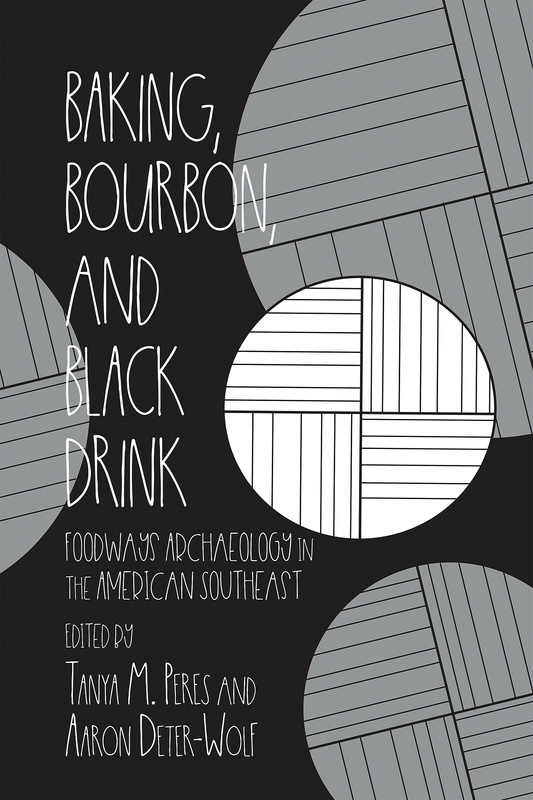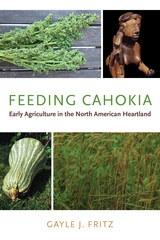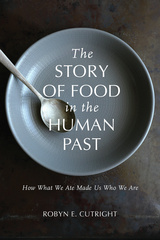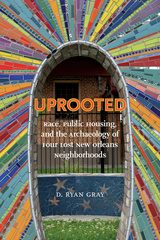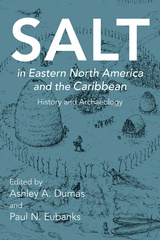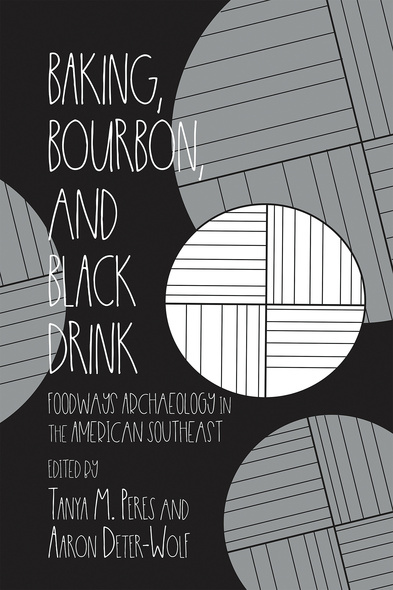
Baking, Bourbon, and Black Drink
Foodways Archaeology in the American Southeast
Understanding and explaining societal rules surrounding food and foodways have been the foci of anthropological studies since the early days of the discipline. Baking, Bourbon, and Black Drink: Foodways Archaeology in the American Southeast, however, is the first collection devoted exclusively to southeastern foodways analyzed through archaeological perspectives. These essays examine which foods were eaten and move the discussion of foodstuffs into the sociocultural realm of why, how, and when they were eaten.
Editors Tanya M. Peres and Aaron Deter-Wolf present a volume that moves beyond basic understandings, applying new methods or focusing on subjects not widely discussed in the Southeast to date. Chapters are arranged using the dominant research themes of feasting, social and political status, food security and persistent places, and foodways histories. Contributors provide in-depth examination of specific food topics such as bone marrow, turkey, Black Drink, bourbon, earth ovens, and hominy.
Contributors bring a broad range of expertise to the collection, resulting in an expansive look at all of the steps taken from field to table, including procurement, production, cooking, and consumption, all of which have embedded cultural meanings and traditions. The scope of the volume includes the diversity of research specialties brought to bear on the topic of foodways as well as the temporal and regional breadth and depth, the integration of multiple lines of evidence, and, in some cases, the reinvestigation of well-known sites with new questions and new data.
This eight-chapter volume focuses on the archaeological, ethnographic, and historic records to interpret the use of foods and beverages in the Southeast within the context of the economic, social, political, and religious realms of society. Five chapters focus on the Mississippian (800–1600 CE) period of the Southeast. Examples of topics covered include analysis of bone marrow extraction and bone grease, which reveal energy-rich food sources in various Mississippian sites in Tennessee; the archaeological evidence and ethnohistory of the ceremonial 'black drink'; an analysis of hominy, which was distributed widely throughout the Southeast during the Mississippian and historic periods and is popularly known today as grits. Also covered is the archaeology and history of bourbon distilleries in Kentucky; research focuses on a three-tiered system of production, from moonshine and farm production to industrial distilleries. The evolution of cooking methods is also explored: in Tennessee and Georgia, earth ovens began appearing in settlements 200–600 CE, while new methods for analyzing pottery form, function, and use-wear are yielding insights to researchers on changing cooking methods. Overall, these articles provide new data and methods of analysis on the role of food in Southeastern societies, and is an important addition to the corpus of studies on foodways in eastern North America.' Recommended.
—CHOICE
‘Baking, Bourbon, and Black Drink is a thematic volume organized around concepts related to understanding the articulation between food, its manipulation by humans, the social contexts where manipulation occurs, and the human purposes behind that manipulation: in other words, ‘foodways.’ While the level of engagement with this concept varies by chapter, most authors do engage with it, approaching it from different perspectives, datasets, geographical regions, and periods of time. Given the topic of the volume and the diversity of the content within the chapters, it is clear this volume will have a lasting impact on archaeological foodways research in the Eastern Woodlands of the United States.’
—Anthropos
‘This volume is an excellent resource on the foodways of the Southeast and provides fascinating new data, as well as revisiting previously studied sites and analyses of foodways.’
—Renee B. Walker, coeditor of Foragers of the Terminal Pleistocene in North America
Baking, Bourbon, and Black Drink is a collection of works elucidating—and in some instances integrating—many diverse aspects of diet and cuisines, written by authors who bring a broad range of expertise to the field of archaeology. It is a major contribution.’
—Gayle J. Fritz, professor of archaeology at Washington University in St. Louis
Aaron Deter-Wolf is a prehistoric archaeologist for the Tennessee Division of Archaeology and coeditor of Drawing with Great Needles: Ancient Tattoo Traditions of North America and Ancient Ink: The Archaeology of Tattooing.
List of Illustrations
Introduction: Foodways Archaeology in the Southeast
Tanya M. Peres and Aaron Deter-Wolf
1. Social Subsistence: Integrating Analyses of Ceramic, Plant, and Animal Remains from Feltus
Megan C. Kassabaum
2. Splitting the Bones: Marrow Extraction and Mississippian Period Foodways
Tanya M. Peres
3. Turkey Foodways: The Intersection of Cultural, Social, and Economic Practices in the
Mississippian Period Southeast
Kelly L. Ledford and Tanya M. Peres
4. The Prehistory and History of Black Drink
Thomas E. Emerson
5. Archaeology of the Whiskey Foodway in Kentucky
Nicolas Laracuente
6. Prehistoric Foodways from the Dust Cave Site
Stephen B. Carmody, Kandace D. Hollenbach, and Elic M. Weitzel
7. Cooking Connects Them: Earth Ovens as Persistent Places during the Woodland Period
Lauren A. Walls and Scot Keith
8. Culinary and Social Requirements of Middle and Late Woodland Swift Creek Pottery
Neill J. Wallis and Thomas J. Pluckhahn
9. Detangling Histories of Hominy: A Historical Anthropological Approach
Rachel V. Briggs
Works Cited
Contributors
Index

